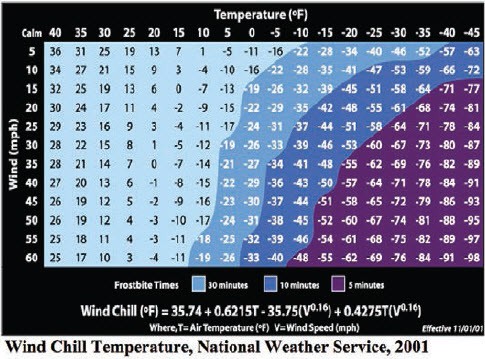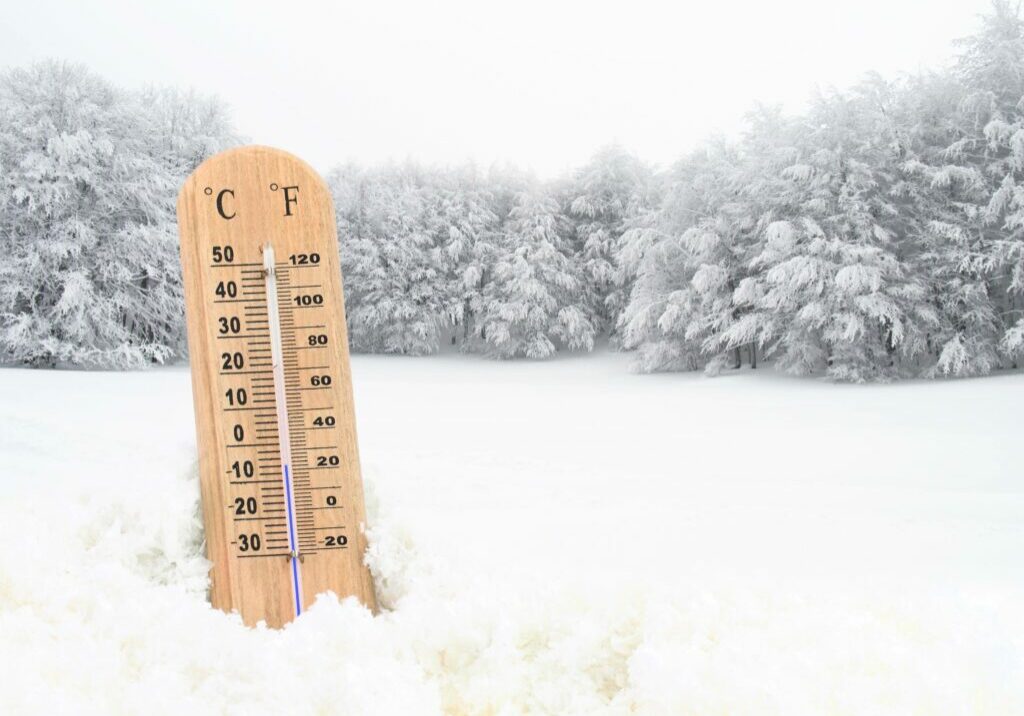Even 40 degrees can be dangerous
Serious consequences of cold stress, including hypothermia, frostbite, and trench foot, can occur at surprisingly moderate temperatures. Custodians, maintenance workers, teachers and other staff who must work outside, or in cold environments such as walk-in refrigerators and freezers, need to be aware of the dangers and how to protect themselves.
Four factors contribute to cold stress: cold temperatures, high or cold wind, dampness, and cold water. In addition, certain medications, such as those for anxiety, depression or nausea, and certain conditions, including low thyroid hormone, diabetes and even being underweight, can increase susceptibility to cold.
Hypothermia
When most people think of hypothermia, they think of frigid temperatures or blizzard-like conditions. Actually, hypothermia occurs most often in the spring and fall, rather than winter.
When in a cold environment, most of the body’s energy is used to keep the internal temperature warm. The body will shift blood flow from the extremities and outer skin to the core (your chest and abdomen). If the body loses heat faster than it can be produced, core temperature will fall. Hypothermia occurs when the core body temperature falls below 95° F. The person begins to shiver and stomp feet in order to generate heat. As the body temperature continues to fall, serious symptoms and even unconsciousness and death can occur.
Low body temperature can affect the brain, making the victim unable to think clearly or move well. This makes hypothermia particularly dangerous, because the victim may not know it is happening and so may do nothing to protect himself or herself. Signs & Symptoms
Frostbite
As heat is drawn from skin to core, exposed skin can cool rapidly. Frostbite occurs when the skin actually freezes and loses water. While frostbite usually occurs when the temperature is 30° F or lower, wind chill factors can allow frostbite to occur in above freezing temperatures. Frostbite typically affects the feet and hands. Signs & Symptoms
Trench foot
Trench foot, or immersion foot, is caused by having feet immersed in cold water for long periods of time. It is similar to frostbite, but considered less severe. Signs & Symptoms
 Wind chill
Wind chill
As wind increases, it draws heat from the body, driving down skin temperature and eventually the core body temperature. Therefore, the wind makes it feel much colder. For example, when the air temperature is 5° F, and the wind speed is 35 mph, your exposed skin experiences conditions equivalent to the air temperature being -21° F. At this wind chill temperature, exposed skin can freeze in 30 minutes. As the chart shows, frostbite can occur after 30 minutes exposure to temperatures as high as 40 F and wind speed as low as 5 mph.
Preventing Cold Stress
You and your UniServ Representative can seek protective contract language to ensure that the following measures are in place:
Appropriate protective clothing is the most important protective measure.
- Wear at least three layers of loose-fitting clothing. Loose clothing allows better ventilation. The outer layer should break the wind (nylon or Gortex®); the middle layer of down or wool should absorb sweat and provide insulation; a third layer of cotton or a synthetic weave should allow air movement.
- Your head should be covered (up to 40 percent of your body heat can be lost when your head is exposed).
- Fingers and hands lose their dexterity at temperatures below 59°F. Find gloves that will allow you to perform the tasks you need to perform and remember replace wet gloves with dry ones.
- Wear insulated boots or other footwear.
- Keep a change of dry clothing available in case work clothes become wet.
Work Practices
- Drink plenty of liquids, avoiding caffeine and alcohol. It is easy to become dehydrated in cold weather.
- Schedule outdoor work during warmer seasons and times of day.
- Take short breaks in warm dry shelters out of the wind and cold.
- Try to work in pairs to keep an eye on each other and watch for signs of cold stress. Supervisors also should watch for signs.
- Use caution when working in walk-in refrigerators and freezers, and let colleagues know your whereabouts.
Engineering Controls
- Radiant heaters may be used to warm workers.
- Use insulating material on equipment handles when temperatures drop below 30° F.
Training
- Workers and supervisors should be trained to recognize potentially dangerous environmental and workplace conditions and the signs and symptoms of cold-induced illnesses and injuries.
For more information
A detailed discussion of hypothermia and cold weather injuries: www.princeton.edu/~oa/safety/hypocold.shtml
Details on hypothermia: www.cdc.gov/niosh/topics/coldstress/#_Hypothermia
